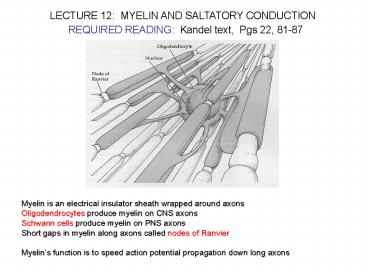LECTURE 12: MYELIN AND SALTATORY CONDUCTION - PowerPoint PPT Presentation
1 / 12
Title:
LECTURE 12: MYELIN AND SALTATORY CONDUCTION
Description:
But move to paranode and then juxtaparanode as structure matures. ... SINCE ONLY FULLY MATURE FIBERS CONDUCT FAST ENOUGH TO MAKE THEM UNNEEDED. ... – PowerPoint PPT presentation
Number of Views:788
Avg rating:3.0/5.0
Title: LECTURE 12: MYELIN AND SALTATORY CONDUCTION
1
LECTURE 12 MYELIN AND SALTATORY CONDUCTION
REQUIRED READING Kandel text, Pgs 22, 81-87
Myelin is an electrical insulator sheath wrapped
around axons Oligodendrocytes produce myelin on
CNS axons Schwann cells produce myelin on PNS
axons Short gaps in myelin along axons called
nodes of Ranvier Myelins function is to speed
action potential propagation down long axons
2
MYELIN SHEATH COMPOSED OF MANY LOOPS OF A GLIAL
PROCESS
Each oligodendrocyte has several processes, each
of which produces a myelin sheath on a different
axon Schwann cells each form only a single
myelin sheath
3
MYELIN SHEATH GENERATED BY CONTINUED MIGRATION OF
PROCESS LEADING EDGE AROUND AXON
While the leading glial process continues to
encircle the axon, the earlier-formed loops
undergo compaction to form the contact myelin
sheath
4
MYELINATED FIBERS VIEWED IN CROSS-SECTION
Low magnification Light microscopy
High magnification electron microsopy
Electron microscopy at very high magnification
reveals alternating major dense lines
and intraperiod lines
5
ORGANIZATION OF THE MYELIN REPEAT PERIOD
PLP is the most abundant protein in CNS
myelin P0 is the most abundant protein in PNS
myelin
6
(No Transcript)
7
ROLE OF MYELIN IN FAST ELECTRICAL TRANSMISSION
Unmyelinated Axon (SLOW CONDUCTION)
Myelinated Axon (FAST CONDUCTION)
SODIUM CHANNELS ONLY AT NODES AT VERY HIGH DENSITY
Action potential at one point along unmyelinated
axon produces current that only propagates short
distance along axon, since current is diverted
through channels in axon membrane. So action
potential can only next occur short distance
away Myelin reduces effective conductance and
capacitance of internodal axon membrane.
(how???) Action potential at node of Ranvier
produces current that propagates 0.5-5 mm to next
node of Ranvier, generating next action potential
8
THIN AXO-GLIAL SPACE AT PARANODE LOOPS CREATES
HIGH NODE-INTERNODE PERIAXONAL RESISTANCE
WHICH ELECTRICALLY ISOLATES INTERNODAL MEMBRANE
Tight junctions between mature loops
Only 20 Angstrom gap between mature paranodal
loop and axonal membrane
SINCE Rparanode gtgtgtgt Raxial Rleak CHARGING
OF INTERNODAL MEMBRANE VERY SLOW AND CHANGE IN
INTERNODE VM IS INSIGNIFICANT
Rparanode
Rparanode
Raxial
Raxial
NODE
NODE
INTERNODE
PARANODE
PARANODE
9
POTASSIUM CHANNEL SHUNT NOT REQUIRED IN MOST
MATURE MYELINATED AXONS
Myelinated axons conduct action potentials at
50 mm/msec Total refractory period of nodal
sodium channels after inactivation Is 5
msec. Therefore, by the time sodium channels
return to rest after an action potential, the
spike has propagated 25 cm away (which is
terminated in most cases) Potassium channel
inhibition in mature myelinated fibers does not
alter conduction or promote misfiring.
10
FORMATION OF NODAL, PARANODAL, AND
JUXTANODAL PROTEIN CLUSTERS DURING MYELINATION
Kv1
Kv1
Sodium channels cluster early at wide immature
nodes. As nodes narrow and mature, sodium
channel density increases. Potassium channels
cluster later and shift their position. They
first appear at nodes, But move to paranode and
then juxtaparanode as structure
matures. POTASSIUM CHANNELS ARE OF CONTINUED
IMPORTANCE DURING MATURATION OF MYELIN, SINCE
ONLY FULLY MATURE FIBERS CONDUCT FAST ENOUGH TO
MAKE THEM UNNEEDED. PERSISTENCE OF POTASSIUM
CHANNELS IN MATURE JUXTAPARANODES MAY
FUNCTIONALLY PROTECT FIBERS IN CASE OF PARTIAL
DE-MYELINATION
11
MUTATIONS CAN CAUSE MINOR OR MAJOR MYELIN LOSS
SHIVERER mutant mouse has almost complete
absence of myelination, due to a failure of
precursor cells to differentiate into
oligodendrocytes Other mutations which
impair myelination are mutations in the major
protein components of the myelin sheath
12
MUTATIONS IN PLP GENE CAUSING HYPOMYELINATION IN
CNS
Similarly, structural mutations in PNS myelin
protein genes cause defective myelination of the
PNS






























